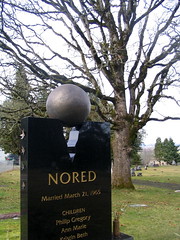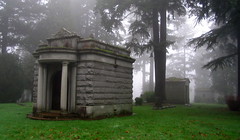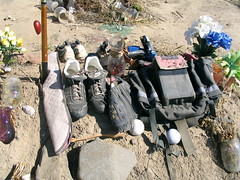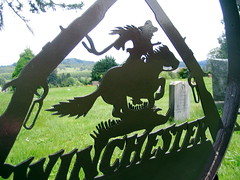
North Palestine Cemetery
I work with sacred ground: cemeteries. There are other types of sacred ground — churches and the like, battlefields, virgin springs — but cemeteries are pretty much universally accepted as sacred ground. At least if they’re your cemetery. If they’re somebody else’s cemetery, they’re fair game for looting. The world’s museums are stuffed with artifacts stolen from cemeteries, up to and including the bodies themselves. But if it’s your grandma and grandpa, hands off. If the looting is done publicly and at a decent time remove, it’s called archaeology.
But the bottom line is a cemetery is a cemetery is a cemetery. Make that your mantra.
A cemetery is composed of dead bodies and their associated artifacts. Among other things, the artifacts tell you the cemetery is there. Without them the bodies belong to the nameless stream of dead people long since disappeared. The most important artifact in a cemetery is the one that tells you that it is there. If it’s lasted for any length of time, it’s probably stone. It’s called a tombstone. The rich can build their whole tomb out of stone; then it’s called a mausoleum. A mausoleum is a glorified tombstone. Among the more notable mausolea in the world are the Taj Mahal and the Egyptian pyramids.

River View Cemetery (Portland)
All cemeteries are liable to be robbed. For some reason human skulls have a value all of their own, not to mention burial offerings. Public theft — that done by archaeologists — has the virtue of A) keeping the artifacts in the public eye, and B) if we’re lucky, advancing our knowledge. Archaeology is first and foremost the study of three things: fire pits, garbage heaps, and cemeteries. Post holes are good, too.
When an archaeologist studies a grave, he or she, aside from looking at the body itself, inventories the associated artifacts, which we commonly call the “grave offerings,” although they all don’t serve the same purpose as the word “offerings” implies; some artifacts are more decoration rather than offerings to the dead or to the spirits of the dead; perhaps “ephemera” might be a better term to cover both. Traditionally, of course, the artifacts are simply taken back home with the archaeologist to their university or other supervising institution, the better to preserve and study them, being the rationale.

Agency Mission Cemetery
Just exactly what the purpose and understanding of ephemera are, though, is a matter of interpretation, and undoubtedly many different forces come into play; but when food offerings are found at a grave site, for instance, it’s not clear that the people who left them actually intended them to be used by the deceased rather than leaving them as a symbolic gesture. One has to presume that the concept of symbolism dates to very early human existence. For the observer, it’s not important that the ephemera are not meant for the deceased’s actual use; they’re significant because they indicate what the survivors — and presumably other people of their time and place — thought important. Grave ephemera, then reflect the people and times in which they are offered. That’s what the stuff found with King Tut does: it helps explain Egyptian life in those times. That’s what archaeologists do: they try to make sense of peoples and times through what they throw away and what they leave for their dead. It’s a very time-consuming task.

Apostolic Cemetery
The first “offering,” as it were, is the marker itself, the object that tells you a grave is there. The marker is important because without it people wouldn’t know where to come to remember the deceased; and ultimately cemeteries are not about stashing the dead somewhere, but about not letting people die. Cemeteries are where the connections between the quick and the dead are maintained. No one in a cemetery, if they have a marker, is truly dead. The marker can be considered “the permanent offering.” It’s the offering that’s not ephemeral. Its importance is that it locates the place of remembrance and the place to which temporary offerings are brought. Without the permanent marker everything quickly fades. Cemeteries, if they don’t obviate the process, at least slow it down.
American grave ephemera include anything left at a grave site excepting the monument, from a simple flower or a pebble to complex assemblages of hundreds of items. Through a combination of decay, cleanup, and theft, grave site ephemera disappears relatively quickly and from times past we have no record of what was left at our graves. We can find grave ephemera from other eras and places where ephemera were buried with the deceased, but for the most part that has never been an American custom; and consequently, most everything ever left at graves here has long since vanished.
Interestingly enough, though, while grave ephemera from other cultures — Peru or Egypt, say — excite great interest and study, to my knowledge local ephemera has always been ignored. Which only means, of course, that vast amounts of information have been lost and that the opportunities are endless. (The worry being, inevitably, that the opportunities will continue being ignored.) With the advent of digital photography it’s become economically feasible to amass large collections of ephemera pictures dripping with anticipation that someone will come and sort them. My only regret is that we don’t know what people left behind at graves in the 1940s, much less the eighteenth century. We only know what the Egyptians left behind.

Brown Cemetery (Beatty, OR)
Grave offerings open tremendous windows into the deceased, their culture, and their times. They tell us more about those who left them than about those for whom they were left. The amount of cultural information packed into one picture of grave site ephemera is quantum leaps above the information conveyed by tombstones alone. Unfortunately though, it’s apparently a case of always being unable to see the forest for the trees. Current ephemera is too much under our nose to pay attention to it, and once it’s gone we never knew it was there in the first place.

Alpine Cemetery
In tombstones the corollary to ephemera is “personalization,” which is the monument industry’s jargon for anything carved into a stone other than names and dates. There has always been some degree of personalization of tombstones, a practice which has waxed and waned in popularity depending on custom, technology, and materials. And there have always been “handmade” markers as well as professional ones. There has been some limited academic attention paid to professional representations in recent tombstone personalization, which has been largely anecdotal rather than analytical and dealt with small databases.
Which is all a round about way of explaining what I do, what the DeadManTalking collection is about. It took me several years to figure it out myself, so don’t worry if it’s not clear to you, it’s still foggy to me. I also know that, whatever I think my mission is today, I will think differently in a year.
I collect grave site offerings, permanent and ephemeral. I am a digital archaeologist. I record objects brought to sacred ground to bask in and add to the spiritual powers present there. I don’t loot any graves. I don’t take anything away to display or to sell. What I do is record a world that will be gone tomorrow. Like the river that is never the same whenever you step into it twice, the cemetery you visit will not be the same one I saw. I’m showing you the soft inside of the culture of the Oregon Territory as it stands at the beginning of the twenty-first century. It will never be seen again. Enjoy it while you can.

Canyon City Cemetery

No comments:
Post a Comment